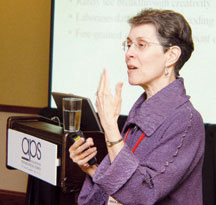Evolving From a ‘Knowledge Economy’ to a ‘Creativity Economy’
Traditionally, creativity has been most often associated with the arts. In some circles, it can even have a negative connotation (think “creative accounting” — Google Enron for details). However, business organizations actually depend on creativity and, as discussed in “Future Directions in Applied Psychological Research on Creativity,” an invited symposium chaired by Maria Rotundo (University of Toronto) at the 22nd Annual APS Convention, creative thinking involves a lot more than paint brushes and musical instruments.
In the current economy, the need for innovation in the workplace is more important than ever. But predicting creative potential in a prospective employee is nearly impossible. Since workplace creativity tends to be highly contextually dependent, how can employers construct an environment to inspire creativity in their employees?
Harvard University’s Teresa Amabile, an APS Fellow and Charter Member, presented her research showing that creative thinking is more likely to occur when an employee is in a positive emotional state. Subsequently, the creative act itself will most likely lead to a positive emotional state, thereby encouraging future creativity. We all know that a good mood is sometimes hard to come by, but Amabile believes that organizations can promote positive emotions in their employees. She found that positive emotions are most likely to occur when employees experience work progress on a regular basis and when they feel both instrumental and interpersonal support within the organization.

Teresa M. Amabile
Jing Zhou of Rice University looked at the flipside of the relationship between emotions and creativity when she asked, “Can Negativity Trigger Creativity?” Zhou showed that distress (e.g., budget deficits, work obstacles, general job dissatisfaction) can actually cause employees to choose to engage in creative thinking. Although each situation is unique, employees tend to tackle difficult workplace situations with creative behaviors when they truly believe it will be meaningful and influential to the organization. “I’m not trying to say, ‘Okay, we need to make people miserable first,’” Zhou assured a packed room. Even so, organizations can recognize minor setbacks as seeds for creativity.
“Competition under certain conditions can provide a major energy source for individuals and can help increase their creativity,” said Christina Shalley of the Georgia Institute of Technology about the benefits of goal-setting and rewards for creativity. Shalley found that creativity is enhanced when employees compete to reach challenging but achievable goals (e.g., the top salesperson for the quarter will receive a bonus). Employees also are more likely to engage in creative thinking when they know that they will be recognized for their effort and financially rewarded when those goals are met.
How does individual creativity translate to creativity in a team setting? The University of Connecticut’s Lucy Gilson spoke about the influence of both individual creativity and dynamics between team members. In a study of teams of engineers, Gilson and her coauthors found that familiarity with other group members’ work backgrounds and expertise tends to increase overall creativity of the team. Diversity is also a key factor, but Gilson warned that this is “somewhat of a double-edged sword” in that team members (especially if they are virtual) might have trouble communicating if their experiences or technical languages are too dissimilar.
During a lively question and answer period, one symposium attendee suggested that employers might want their employees to function like MacGyver — that is, in a crisis they will consider trying things that they would have otherwise dismissed. Although not everyone can be an 80s television hero, perhaps employers can learn to inspire the MacGyver inside their employees by looking to the latest research on creativity.





APS regularly opens certain online articles for discussion on our website. Effective February 2021, you must be a logged-in APS member to post comments. By posting a comment, you agree to our Community Guidelines and the display of your profile information, including your name and affiliation. Any opinions, findings, conclusions, or recommendations present in article comments are those of the writers and do not necessarily reflect the views of APS or the article’s author. For more information, please see our Community Guidelines.
Please login with your APS account to comment.